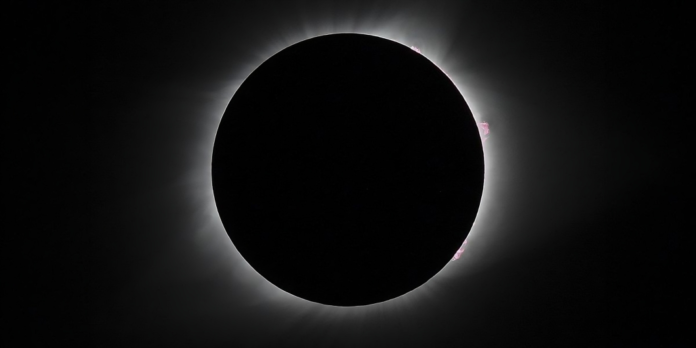As the celestial ballet of sun, moon and Earth seamlessly choreographs the cyclical rhythms of night and day, a singular event next month will disrupt this perpetual cadence – plunging a narrow corridor of America into an eerie, ephemeral twilight when dawn should be daylight’s peak. This paradoxical primetime will be the Great American Eclipse on April 8th, 2024.
From the rugged Pacific shores to the historic Atlantic coastline, a moon’s silhouette will dramatically obscure the sun’s brilliant golden rays for a fleeting 2 minutes and 40 seconds. This cosmic choreography promises spectacular vistas of the shimmering solar corona and phenomenal celestial sights like Baily’s Beads shimmering along the lunar edge.
Yet as this highly anticipated event approaches, atmospheric circumstances may upend or enhance the grand spectacle. Meteorologists are closely tracking an intense storm system barreling across the nation’s heartland that could shroud the eclipse’s narrow path of totality in a vast celestial cloaking device – opaque cloud cover.
The fickle prospect of cloud-maring has sent many eager eclipse chasers into astronomical anguish over squandered opportunities to glimpse this generation-defining cosmic phenomenon. However, new enlightening perspectives reveal how leaden skies cannot completely occult the deeper dramas and terrestrial reverberations triggered when the moon entirely eclipses the sun.
“Even if the total eclipse is obscured behind an overcast veil, observers can still experience startling physical impacts and atmospheric anomalies that reveal our planet’s intricate relationship with our star,” explains Dr. Alan Yeager, an astronomer at the University of Chicago.
As the moon’s umbral shadow sweeps across the continent in a77-mile wide path, areas engulfed in totality will experience a stark paradox – abrupt night usurping midday despite the sun’s presence in the sky. This ephemeral darkness sparks a bizarre choreography of terrestrial reactions.
Within the lunar umbra’s cosmic shadow, temperatures tumble as solar heating abruptly ceases. Gentle breezes grind to a calm halt as atmospheric circulatory patterns pause. The landscape takes on an eerie, dusky, sunset-like hue as indirect lighting from the sun’s faint outer corona provides the sole illumination.
“It’s a viscerally disorienting experience to have dawn’s darkness interrupt what should be midday brightness,” describes Yeager. “Suddenly the world is bathed in the faint krypton and xenon hues we’re accustomed to at twilight. It’s as if the natural order has been turned utterly askew by the clockwork motions of sun, moon and Earth.”
While cloud cover would obscure stunning views of the solar corona, nature’s paradoxical nighttime sparked by totality would still be palpably felt even if the moon’s motion is unseen.
The terrestrial impacts extend far beyond human senses too. Certain species of flowers abruptly close their petals, fooled into thinking nightfall has arrived on cue. Cows and livestock have been documented plodding back to their barns, instinctively adhering to deeply rooted diurnal patterns upended by the improvised darkness.
Even the upper atmosphere reacts with unusual fanfare. Radar observations taken during past total eclipses detected ripples and oscillations in the ionosphere’s concentrated bands of electrically-charged particles. These atmospheric undulations are aftershocks of sudden thermal readjustments following the swift withdrawal of solar radiation.
“From flowers to the ionosphere, a total solar eclipse essentially turns the atmospheric dials back some six hours – temporarily resetting our planet’s diurnal rhythms to dusk-like conditions in the span of a few moments,” says Yeager. “It’s an unrivaled opportunity to study how deeply intertwined Earth’s physical and biological processes are with the perpetual solar pulse.”
For those situated outside the path of totality, the celestial point of perfection for witnessing all of these terrestrial reverberations would be locations along the boundaries of the path. Here observers can experience deepening twilight as the moon’s curved shadow encroaches, while still having clear views to the west to observe the heavenly choreography of eclipse.
“Standing on the edge allows you to viscerally experience the landscape’s metamorphosis while still having an unobstructed view of the sun’s crescent sliver in the sky,” Yeager explains. “It’s anakin to witnessing both the grand theatre of the celestial movements while perceiving their profound impacts on the terrestrial stage.”
However, should clouds stubbornly blot out all celestial vistas, the residual atmospheric and biological reverberations of totality would still unfold as profound reminders of our living Earth’s intimate symbiosis with the perpetual solar rhythms.
Therefore, while eagerly hoping for cloud-free skies, even an obscured view cannot entirely eclipse the deeper revelations sparked when the moon’s umbral shadow sweeps across America next month. By monitoring nature’s peculiar responses, curious observers would still unlock rare windows into celestial mechanisms usually occurring imperceptibly in plain sight.
As Yeager succinctly concludes, “The greatest eclipse drama often occurs right here on the terrestrial sphere we call home – backstage to the celestial choreography unfolding above. So keep an equally curious eye turned both skyward and towards the living world around you.”
No matter the atmospheric theatrics, the Great American Eclipse of 2024 promises revelations into our intricately intertwined existences with the timeless cosmic harmonies governing our solar system’s elegant ballet.





















